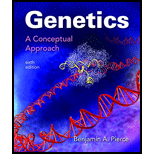
a.
To determine:
The progeny with the types of combs from the following cross
Introduction:
The different shapes of the comb in chicken are caused due to the interaction between two different genes. This study was conducted by William Bateson and R.C Punnett and found that different varieties of chickens have different shapes of the comb. For example – Wyandottes have a “rose” comb and Brahmas have a “pea” comb. Punnett and Bateson crossed a Brahma chicken and a Wyandotte chicken, all the offspring produced in the
a.
Explanation of Solution
A cross between
Hence, all the progeny produced by a cross between
will have a walnut comb.
b.
To determine:
The progeny with the types of combs from the following cross
Introduction:
The different shapes of the comb in chicken are caused due to the interaction between two different genes. This study was conducted by William Bateson and R.C Punnett and found that different varieties of chickens have different shapes of the comb. For example – Wyandottes have a “rose” comb and Brahmas have a “pea” comb. Punnett and Bateson crossed a Brahma chicken and a Wyandotte chicken, all the offspring produced in the
b.
Explanation of Solution
A cross between
Hence, the progeny produced are,¼ walnut, ¼ single, ¼ pea, and ¼ rose.
c.
To determine:
The progeny with the types of combs from the following cross
Introduction:
The different shapes of the comb in chicken are caused due to the interaction between two different genes. This study was conducted by William Bateson and R.C Punnett and found that different varieties of chickens have different shapes of the comb. For example – Wyandottes have a “rose” comb and Brahmas have a “pea” comb. Punnett and Bateson crossed a Brahma chicken and a Wyandotte chicken, all the offspring produced in the
c.
Explanation of Solution
A cross between
Hence, the progeny produced by this cross has a phenotypic ratio:
d.
To determine:
The progeny with the types of combs from the following cross
Introduction:
The different shapes of the comb in chicken are caused due to the interaction between two different genes. This study was conducted by William Bateson and R.C Punnett and found that different varieties of chickens have different shapes of the comb. For example – Wyandottes have a “rose” comb and Brahmas have a “pea” comb. Punnett and Bateson crossed a Brahma chicken and a Wyandotte chicken, all the offspring produced in the
d.
Explanation of Solution
A cross between
Hence, the progeny produced by this cross will be in the phenotypic ratio of
e.
To determine:
The progeny with the types of combs from the following cross
Introduction:
The different shapes of the comb in chicken are caused due to the interaction between two different genes. This study was conducted by William Bateson and R.C Punnett and found that different varieties of chickens have different shapes of the comb. For example – Wyandottes have a “rose” comb and Brahmas have a “pea” comb. Punnett and Bateson crossed a Brahma chicken and a Wyandotte chicken, all the offspring produced in the
e.
Explanation of Solution
A cross between
Hence, the progeny produced by this cross will be in the phenotypic ratio of
f.
To determine:
The progeny with the types of combs from the following cross
Introduction:
The different shapes of the comb in chicken are caused due to the interaction between two different genes. This study was conducted by William Bateson and R.C Punnett and found that different varieties of chickens have different shapes of comb. For example – Wyandottes have a “rose” comb and Brahmas have a “pea” comb. Punnett and Bateson crossed a Brahma chicken and a Wyandotte chicken, all the offspring produced in the
f.
Explanation of Solution
A cross between
Hence, the progeny produced by this cross will be in the phenotypic ratio of
Want to see more full solutions like this?
Chapter 5 Solutions
Genetics: A Conceptual Approach
 Human Anatomy & Physiology (11th Edition)BiologyISBN:9780134580999Author:Elaine N. Marieb, Katja N. HoehnPublisher:PEARSON
Human Anatomy & Physiology (11th Edition)BiologyISBN:9780134580999Author:Elaine N. Marieb, Katja N. HoehnPublisher:PEARSON Biology 2eBiologyISBN:9781947172517Author:Matthew Douglas, Jung Choi, Mary Ann ClarkPublisher:OpenStax
Biology 2eBiologyISBN:9781947172517Author:Matthew Douglas, Jung Choi, Mary Ann ClarkPublisher:OpenStax Anatomy & PhysiologyBiologyISBN:9781259398629Author:McKinley, Michael P., O'loughlin, Valerie Dean, Bidle, Theresa StouterPublisher:Mcgraw Hill Education,
Anatomy & PhysiologyBiologyISBN:9781259398629Author:McKinley, Michael P., O'loughlin, Valerie Dean, Bidle, Theresa StouterPublisher:Mcgraw Hill Education, Molecular Biology of the Cell (Sixth Edition)BiologyISBN:9780815344322Author:Bruce Alberts, Alexander D. Johnson, Julian Lewis, David Morgan, Martin Raff, Keith Roberts, Peter WalterPublisher:W. W. Norton & Company
Molecular Biology of the Cell (Sixth Edition)BiologyISBN:9780815344322Author:Bruce Alberts, Alexander D. Johnson, Julian Lewis, David Morgan, Martin Raff, Keith Roberts, Peter WalterPublisher:W. W. Norton & Company Laboratory Manual For Human Anatomy & PhysiologyBiologyISBN:9781260159363Author:Martin, Terry R., Prentice-craver, CynthiaPublisher:McGraw-Hill Publishing Co.
Laboratory Manual For Human Anatomy & PhysiologyBiologyISBN:9781260159363Author:Martin, Terry R., Prentice-craver, CynthiaPublisher:McGraw-Hill Publishing Co. Inquiry Into Life (16th Edition)BiologyISBN:9781260231700Author:Sylvia S. Mader, Michael WindelspechtPublisher:McGraw Hill Education
Inquiry Into Life (16th Edition)BiologyISBN:9781260231700Author:Sylvia S. Mader, Michael WindelspechtPublisher:McGraw Hill Education





